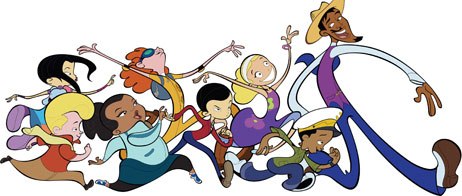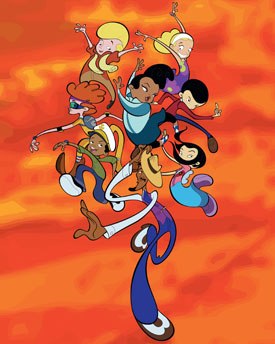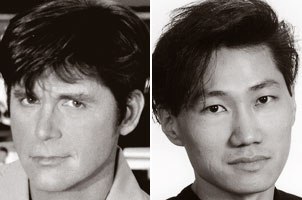Joe Strike chats with Tom Lynch about collaborating with Andr3000 Benjamin on Cartoon Networks new animated series, Class of 3000.

Two creative kingpins TV producer Tom Lynch and musician André 3000 Benjamin have joined forces to collaborate on genre-stretching project Class of 3000. All Class of 3000 images © & 2006 Cartoon Ne
When the number one name in tween TV joins forces with a multitalented musician/performer in a field neither one has experience in, its hard to predict the results or fathom the reason for the effort in the first place. Is it an ego trip for all involved, a serious commitment to a new medium, or a use-my-name-and-collect-the-check exercise in dilettantism?
All indications are that Class of 3000, the new animated series premiering Nov. 3, 2006, on Cartoon Network is the real deal: two creative kingpins TV producer Tom Lynch and musician André 3000 Benjamin collaborating on a genre-stretching project thats taking them and the medium theyve chosen in new directions.
With a 20-year record as the king of tween programming, Lynch was looking for a new world or two to conquer. Beginning with Kids Incorporated in 1984, Lynch is responsible for some of the most successful live-action shows aimed at the 9-12 age group, including Nickelodeons The Secret World of Alex Mack. It was on a trip to Atlanta to pitch some projects at Turner when Lynch sat down with an old friend Adult Swims Mike Lazzo.
As Lynch recounts the conversation, Mike asked me what I wanted to do next. I told him I really wanted to do an animated show, and I want to have some music in it. He said, great, you have a pilot with us do what you want to do.
We started talking about artists we liked he was talking about animators, I was talking about musicians. It was the kind of conversation you have with people youve known a long time about whats moving you artistically.
Music-wise, the two men discovered they shared an enthusiasm for the hip-hop duo Outkast, and the half of it known as André 3000 Benjamin in particular. After various people called other peoples people, Benjamin met with Lynch and Lazzo for a three-way, three-hour get together. As a Grammy-winning musician (Speakerboxxx/The Love Below), film actor (Idlewild), painter and clothing designer, Benjamin obviously had an excess of "free time" on his hands. The meeting ended with Benjamin signing on to the project with the suggestion that the show be set in Atlanta, his (and Cartoon Networks) hometown.
It was the beginning of a two-and a-half-year development process, the first year of which consisted of Lynch and Benjamin brainstorming ideas and considering different visual styles. The project quickly outgrew its original Adult Swim conception. I always wanted to do a show about a kids point of view of the denizens of the night around them, Lynch recalls. Street people always had a great fascination for me. It was originally rougher and harder, but as we talked it evolved into more of a regular type of show. It was Michael Ouweleen [Cartoon Networks svp/creative director] who said, Guys, were going to get a much bigger audience if you do this in primetime. André said Okay, but it has to be the most edgy show in primetime.

After Benjamin signed on to do the show, he and Lynch embarked on a two-and a-half-year development process. The project quickly outgrew its original Adult Swim conception and became a primetime show.
While several earlier Lynch shows (including Alex Mack, Galidor and The Journey of Alan Strange) featured CGI effects, Class of 3000 would be his first animated 2D effort. I really had a lot to learn, Lynch admits. Cartoon Network gave me Joe Horne who had an incredible résumé, including Teamo Supremo and The Boondocks, and going back to Pee-Wees Playhouse a really great, eclectic collection of shows. I told him youre going to have to teach André and me. This is a new area for us.
Horne became the projects production supervisor and director. Nonetheless, Lynch confesses to making every mistake anybody could make, and adding some new ones on his road to creating a 2D series. I think my worst one was when the cut came back [from overseas animation]. I looked at it and said, Okay, I have some rewrites. They said, Uhhh, you get some retakes I had thought retakes meant whole scenes, but it was only moments or close-ups. That was an education right there, because in live-action I rewrite all the way through post-production, I change everything all the time.
While not an animation playa, Benjamin had some definite ideas about the look he wanted. We didnt know a lot about animation, but not knowing gave us a kind of innocence. We were familiar with the shows that were on Cartoon Network already, and they had a certain style of their own really boxy and squarey, like Hi Hi Puffy Ami Yumi. We wanted a different kind of flow; we wanted our show to look different. I think that gave us the original spark of lets have a flowy kind of look.
Creating that flowy look fell to character designer David Colman and art director Valerio Ventura. Eighteen different designers tried their hand at the shows characters before Colman (who worked on The Polar Express and Open Season) came along. Lynch admits that André and I are very focused on what we want, but we didnt have their language. They had to interpret what we were asking for. André wanted it to be cool and original looking; my notes were that it had to have a lyricism, a movement and body style almost like musical notes.

There isnt a straight line among the curvy, willowy cast of characters. Creating that flowy look fell to character designer David Colman and art director Valerio Ventura.
Colmans characters hit the bulls eye. There isnt a straight line among the curvy, willowy cast of characters, all of whom look like they could indeed flow rather than walk across the frame. Filling those frames are the shows jazzy spotted backgrounds, the work of Valerio Ventura, the shows supervising art director. Venturas credits include visual development on Disney features dating back to The Rescuers Down Under, but for Class of 3000, he put the (not-quite) finished art on a table, and according to Lynch literally threw paint across them Jackson Pollock-style. Its a contemporary design that gives the frames a depth and dimension. We loved it.
While Colman finalized the look of the characters, Benjamins childhood experiences and friendships helped develop their personalities, not unlike the way Bill Cosby and Richard Pryors younger days inspired their Fat Albert and Pryors Place Saturday morning shows. I was telling Tommy about how I grew up, Benjamin relates, and hes like, oh, thats it! Theres a character right there. Those characters include among others, soft-spoken, rich kid Eddie, boy genius Philly Phil, tough but kind-hearted Tamika and Andrés youthful stand-in Lil D. According to Lynch, André told me how he took a bus two to three miles to school because his mother wanted him to go to a school with music in another section of town. I said thats great, thats our lead character.
My mom was smart enough to send me to school in Buckhead, explains Benjamin, I guess you would call it the place to be in Atlanta. Im in school with the mayors kids, my friends were East Indian, people from France. I was getting all kinds of influences and I thought it would be cool to have these different types of characters, different nationalities coming together as music. Everybody loves music, you know.
Class of 3000 is the story of disaffected superstar Sunny Bridges (voiced by Benjamin himself) who abandons his career to teach a class of musical prodigies. These are regular kids that are gifted, but theyre still regular kids, he continues. Its kind of a coming of age story, and on this series were coming of age through music. I think this show presents a really whimsical, fun side of life that we havent seen since Peanuts.

Benjamins childhood experiences and friendships informed the shows story and characters. He voices disaffected superstar Sunny Bridges (right) who abandons his career to teach a class of musical prodigies.
3000s characters are voiced by cartoon vets Tom Kenny (SpongeBob SquarePants), Phil LaMarr (Samurai Jack), Jennifer Hale (PowerPuff Girls), Crystal Scales (Jimmy Neutron), Janice Kawaye (Hi Hi Puffy AmiYumi) and Jeff Glen Bennett (Johnny Bravo). The key role of Lil D went to Small Fire, an Atlanta comedienne from Benjamins old neighborhood. She was the local tomboy she would beat us in basketball, Benjamin says. He had been thinking of her for the role from the start, and finding her was relatively simple: My mom went to her moms house to ask where she was.
Lynch brought veteran animation scripter Patric Verrone (Futurama, The Simpsons, The Critic) aboard as the series story editor. However, his and Benjamins greatest coup may have been lining up an all-star roster of guest art directors from both within and without the animation world. Each episode features a music video sequence with its own unique look, set to an original André 3000 tune. Talent on the order of Ren & Stimpys John Kricfalusi, comics artist and illustrator Bill Sienkiewicz, cartoonist Kyle Baker and Aeon Flux creator Peter Chung will be overseeing segments that Benjamin compares to mini-Fantasias within each episode.
According to Lynch, the artists all were given free reign; staying on model was strictly optional. We dont want that. Were encouraging them to bring own game to it that will still work in the body of our storytelling. We told John K, take our characters and make them yours, which is exactly what he did. Peter Chung did a sci-fi version it became a Mission: Impossible number. Were doing a half hour show, not 11 minute cartoons; character and story are very important and André writes his songs to make sure theyre still continuing with the story.
We have a couple of guys coming in from painting, famous artists. I cant tell you who because were waiting to see if their work translates into animation. It will be interesting, and were always trying to push it further. We may trip a little bit but I think overall were going to come up with something esthetically pleasing and artistic, and set a new tone for it all.
Beyond the music videos, Atlanta native and B-52s band member Pat Irwin oversees the shows score with Benjamin. André wanted an Atlanta/southern vibe to the music, says Lynch, and Pat helps bring that. André supervises all the music, he does a song every week and did the theme song.
A lot of these projects where a celebrity of his stature is involved, people think hes just putting his name on, but hes involved with every story idea with me, every design idea, every music video idea. He does his own voice too. It wasnt a vanity project for him hes showing up for it, not just slacking off.
In fact, André 3000 Benjamins personal stake in Class of 3000 is unmistakable. Its kind of like a rebel thing, he says. I guess its the Ted Turner spirit in me. They told Ted he could never do it in the South, and look at what hes done.
I always like to prove people wrong, man. Weve seen New York streets, weve seen L.A. streets, but theres never been a show from here. This whole Cartoon Network opportunity came to me I wasnt sitting at home saying, I want to do an animated show it organically came together.

Lynch and Benjamins greatest coup is lining up star guest art directors, including Ren & Stimpys John Kricfalusi (left) and Aeon Flux creator Peter Chung to create a music video sequence that is featured in each
Benjamin goes on to reveal another aspect to his hopes for the series: Theres a kind of save the music spirit in the show. Right now theyre taking music programs out of schools, and I think musics a key part of life. As a kid, you have so many influences. A kid can look at Lil D drumming and say, Mom, I want a drum set, or look at Madison and say, Man, shes cool. I want to play her violin. Hey mom, get me a violin! I think kids are going to be impressed that normal kids theyd want to hang out with are playing the harp, the violin, a big trumpet or something like that. I think thats going to be inspiring to them.
So its not all gags and funny, even though thats a huge part of what we do. But I think people will be able to feel the realness in it, too. One of my main goals in the show is to have kids grow up and when theyre 25, 30 years old. think back, Man, do you remember when Class of 3000 was on? Do you remember this song?
Joe Strike is a regular contributor to AWN. His animation articles also appear in the NY Daily News and the New York Press.







